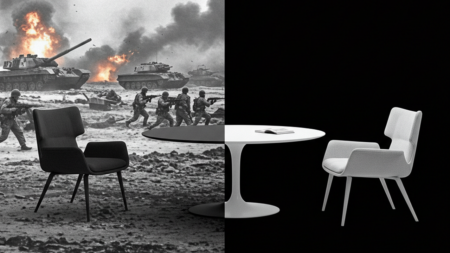Salone del Mobile has seen thousands of designers over the years. From icons like Gabriella Crespi to new design sensations like Patricia Urquiola and Ramon Esteve, the biggest furniture fair on the earth has served as a launching pad for some of the most prominent and established designers in the industry.
One of these designers whom even Salone del Mobile paid a tribute to was Elio Martinelli. The late Italian lighting designer and founder of Martinelli Luce lighting company was not just a veteran of Salone del Mobile but also a guiding light for hundreds of rookies and design enthusiasts. Such was his aura that even designers like Marc Sadler and Marcello Morandini have designed products for his studio.
I had the pleasure to interview Marco Ghilarducci, the grandson of the late Elio Martinelli, who serves as the current CEO of Martinelli Luce. Marco has been involved in the company since 2000 and brings a digital approach to the table. In an exclusive conversation, he speaks about the challenges involved in running a lighting studio and the future of the company alongside sharing his thoughts on his grandfather’s legacy and contribution to the world of design.
Homecrux (HC): From a degree in logistics and production engineering to managing the affairs at Martinelli Luce; how has the journey been for you so far? How big an inspiration has Emiliana Martinelli been along the way?
Marco Ghilarducci (MG): While my educational background is in engineering, I have been in the world of design since I was a child, being the grandson of Elio Martinelli, the founder of the Martinelli Luce company. Having lived in close contact with him, as well as with my mother Emiliana Martinelli, they certainly transmitted their passion for design to me.

HC: Tell us about your grandfather’s legacy and his contribution to the world of design. Is Martinelli Luce still attached to the founder’s ideology and approach?
MG: I think my grandfather made a big contribution to the world of design. His passion and vision for design was very groundbreaking for the times in which he lived. His products have always been pioneers. He has never followed trends and has always believed in his vision of creating products with a minimal, geometric and nature-related design. All his products always have a link to nature and animals, just think of his most important product designs such as Cobra, Serpente (snake), Le Rondini (swallows), Nuvole Vagabonde (wandering clouds) and many others.

HC: What’s your basic design style? You’ve just designed the lamp (TX 1) for your studio. Could we expect more inspiring work from you in the future?
MG: The TX1 lamp was the first project that I designed and I really enjoyed doing it. As I mentioned before, I had always seen both my grandfather and my mother designing at all times of the day, so as it happens, I had the desire to try it myself. I have a great passion for technical design using computer tools such as three-dimensional CAD, but my time is very limited due to my position within the company as CEO. I will certainly try to design other products when I have the right inspiration. At the moment, I don’t have any projects coming out soon.

Homecrux: What’s your take on Italy as the hub of design and how traditional Italian techniques and materials are being used in new and unexpected ways?
MG: I firmly believe that Italy is at the heart of design. I believe that the passion and creativity that Italians have is unique in the world. We have an outstanding territory and exceptional craftsmen whose creativity has allowed us to create not only new products but also new ways of producing. Let us not forget that in our country, in addition to craftsmen, we also have exceptional companies in the field of mechanical design that export new production technologies all over the world.
Homecrux: Martinelli Luce plans to exhibit Avro Pendant Lamp at Salone del Mobile 2023. Tell us about the collaboration with Studio Natural.
MG: The Avro lamp will be presented during Euroluce (the biennial Salone del Mobile dedicated to lighting). I think it is a very interesting product because it combines design with functionality. In fact, it is possible to use the electrical socket at the bottom of the lamp to connect any type of electrical device. The socket is not invasive but is present and therefore freely usable when the user needs it. The product is perfect for home use above a living room or kitchen table and also for commercial, restaurant, or cultural environments.

The relationship with Studio Natural is very strong, we have known each other for many years and actively collaborate on all the projects we realize. There is always an exchange of ideas and technology between the studio and the company, and this is the basis for realizing an excellent project down to the last detail.

With them we have realized many other projects and have had excellent results: for example, the Fluida lamp (that received an honorable mention at the Compasso d’oro 2016) but also technical lamps such as the Sistema U and the Bruco for outdoor use.
Homecrux: How different is designing light fixtures from furniture? What sort of challenges do you confront as a lighting design studio?
MG: Designing a lighting product is completely different from designing a piece of furniture, the electrical and lighting aspect heavily influences the design process. There are many components such as the light source, the heat sink, the wiring, and especially the power supply that have volumes that must be considered during the design phase and can heavily revolutionize the design. In addition, it is necessary to evaluate the aspects related to the type of light we want to do with our product, diffused light, direct light, indirect light, warm light, and cold light, which is related to the use of the product itself according to the environment in which it will be placed.
Homecrux: Your studio has worked with some of the top designers in the industry. How was the experience collaborating with them?
MG: The company has worked with many designers over the years, both famous and young designers. One of the most important is certainly the architect Gae Aulenti with whom we made some of the icons of our catalog, the Pipistrello, and the Ruspa. Others I can mention are Sergio Asti with whom we made the Profiterolle and Visiere lamps. But in addition to the most famous names, we also collaborate with young studios that often have ideas outside the box and allow us to be innovative all the way around, as happened for example with the Avro lamp by Studio Natural.
Homecrux: How has the design landscape changed with the introduction of technology? How does a studio like yours adapt to change?
MG: We have always worked to take advantage of the latest technologies on the market, it has always been our goal. Many of the lamps created over the years have technology as a key element. The Pipistrello and Serpente lamps themselves were born using new production technologies that were not yet on the market, and we directly invented these new ways of production. In addition, the use of LEDs, the source of each lamp, which is present today as the only lighting technology, is certainly a revolution in the field of lighting and has permitted the creation of new lighting products with exceptional characteristics from the lighting technology point of view and has allowed the creation of products with even more minimalist designs.
Homecrux: What is the future of design? Do you believe AI could possibly take design jobs?
MG: The future of design will certainly be increasingly linked to the use of digital technologies, design and communication systems will be increasingly present in every product.
I am a digital enthusiast, so I have been analyzing and testing this new technology, Artificial Intelligence, for quite some time now. I can say that I have been very impressed by the possibilities it could offer in every field in the future, but I believe that we are still a long way from being able to completely replace human intelligence. The creativity and above all the emotions that each person has can never be replaced by a computer; logic alone, which is the strong point of computers, is not enough to realize a good project.
Let’s not forget that it always takes a human to ask the computer what it wants designed and how. You need the design input and what you want to achieve. A computer cannot know this and never will…
We would like to thank Marco for taking the time to answer our questions.
Follow Homecrux on Google News!




